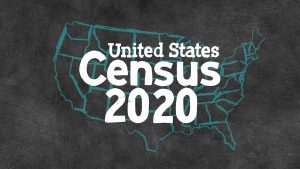 By Brandon Martin
By Brandon Martin
There are two major ways to make an impact on your country this year. The first is to vote. The other is to participate in the U.S. Census.
Article 1, Section 2 of the U.S. Constitution has mandated that the country count its population every 10 years since 1790. The data that is collected is used for a variety of purposes, but one of the biggest affects how citizens are represented in their government.
The census determines the number of seats each state has in the House of Representatives. It also is used to draw congressional and state legislative districts.
Along with congressional boundaries, the census will have a real effect on how communities are shaped over the next decade. The allocation of billions of dollars in federal money to state and local governments is determined with the numbers. This influences highway planning and construction, public transit systems, Head Start programs, wildlife preservation efforts, and social welfare programs such as Medicare, Medicaid and Supplemental Nutrition Assistance Program (SNAP) benefits.
“There is a lot of money at stake; $675 billion of federal aid that is going to be dispersed,” said Michael Stowers, of the U.S. Census Bureau. “It’s based on your census numbers. Not only the legislative boundaries being drawn, but a lot money is going to be portioned out. Things like hospitals, roads, Medicaid, Medicare, SNAP programs, Section 8 housing,” he said.
On Apr. 1, Census Day will be observed across the nation. Every home will receive an invitation to participate in the 2020 Census. There will be three different ways to respond: online, via telephone or by mail.
Those that haven’t responded can expect a Census Bureau representative to arrive at their houses between May and July.
Stowers estimated that $2,000 is lost “for every person that doesn’t get counted. That is money that is not flowing into your community.”
For those worried about speaking with governmental representatives, a preset list of questions will be asked. The questions and the reasons for each is listed below:
*How many people were living or staying in this house, apartment, or mobile home on April 1, 2020? This question is asked to get an understanding of everyone living or sleeping in a household. This includes children, roommates, and family and friends.
*Were there any additional people staying here on April 1, 2020, that you did not include in Question 1? This question is asked to ensure that every person is counted only once and that everyone that should be counted will be counted.
*Is this house, apartment, or mobile home (mark ONE box) … owned by you or someone in this household with a mortgage or loan?
This helps produce statistics about homeownership and renting. The rates of homeownership serve as one indicator of the nation’s economy. They also help with administering housing programs, planning, and decision-making.
*What is your telephone number?
The Census Bureau asks for your phone number in case there are any questions about your census form. They will only contact you for official census business, if needed.
*What is Person 1’s name?
Person 1 is whoever pays the rent or owns the residence. If the owner or the person who pays the rent does not live at the residence, any adult living there can be Person 1, with any additional adults to be listed later. The Census Bureau asks a series of questions about each member of the household. This allows them to establish one central figure as a starting point.
*What is Person 1’s sex?
This allows the Census Bureau to create statistics about males and females, which can be used in planning and funding government programs. This data can also be used to enforce laws, regulations, and policies against discrimination.
*What is Person 1’s age and what is Person 1’s date of birth?
Person 1’s age should be as of April 1, 2020. For babies less than a year old, do not write the age in months. Write 0 as the age. The U.S. Census Bureau creates statistics to better understand the size and characteristics of different age groups. Agencies use this data to plan and fund government programs that support specific age groups, including children and older adults.
*Is Person 1 of Hispanic, Latino, or Spanish origin?
For this census, Hispanic origins are not considered races. Hispanic origin can be viewed as the heritage, nationality, lineage, or country of birth of the person or the person’s parents or ancestors before arriving in the United States. People who identify as Hispanic, Latino, or Spanish may be any race. These responses help create statistics about this ethnic group. This helps federal agencies monitor compliance with anti-discrimination provisions, such as those in the Voting Rights Act and the Civil Rights Act.
*What is Person 1’s race? Mark one or more boxes AND print origins: White; Black or African American; American Indian or Alaska Native; Chinese; Filipino; Asian Indian; Vietnamese; Korean; Japanese; other Asian; Native Hawaiian; Samoan; Chamorro; other Pacific Islander; some other race.
This allows the Census Bureau to create statistics about race and to analyze other statistics within racial groups. This data also helps federal agencies monitor compliance with anti-discrimination provisions, such as those in the Voting Rights Act and the Civil Rights Act.
*Print name of Person 2.
The next person in your household is listed as Person 2. The 2020 Census asks information about each member of your household. This question identifies the next person to refer to in the ensuing questions. This process repeats for each person in your home.
*Does this person usually live or stay somewhere else? Mark all that apply: no; yes, for college; yes, for a military assignment; yes, for a job or business; yes, in a nursing home; yes, with a parent or other relative; yes, at a seasonal or second residence; yes, in a jail or prison; yes, for another reason.
This question helps ensure that the Census Bureau is counting everyone once, only once, and in the right place.
*How is this person related to Person 1? Mark ONE box; opposite-sex husband/wife/spouse; opposite-sex unmarried partner; same-sex husband/wife/spouse; same-sex unmarried partner; biological son or daughter; adopted son or daughter; stepson or stepdaughter; brother or sister; father or mother; grandchild; parent-in-law; son-in-law or daughter-in-law; other relative; roommate or housemate; foster child; other non-relative.
Relationship data is used in planning and funding government programs that support families, including people raising children alone.
There are some ways to help identify whether someone is from the Census Bureau or not. Bureau representatives will not ask for social security numbers, money or donations, political affiliations, bank or credit card numbers, or citizenship status.
Personal information must be kept confidential. Federal law mandates that the Census Bureau protect your information, and only use the data gathered for statistical purposes.
In December, the Census Bureau will deliver the apportionment counts to the President and Congress.
The U.S. must count its population every 10 years. Data gleaned from the count is used for a variety of purposes – from representation in government to highway planning and construction, public transit systems, Head Start programs, wildlife preservation efforts, social welfare programs such as Medicare, Medicaid and SNAP benefits. (Photo from census.gov)




